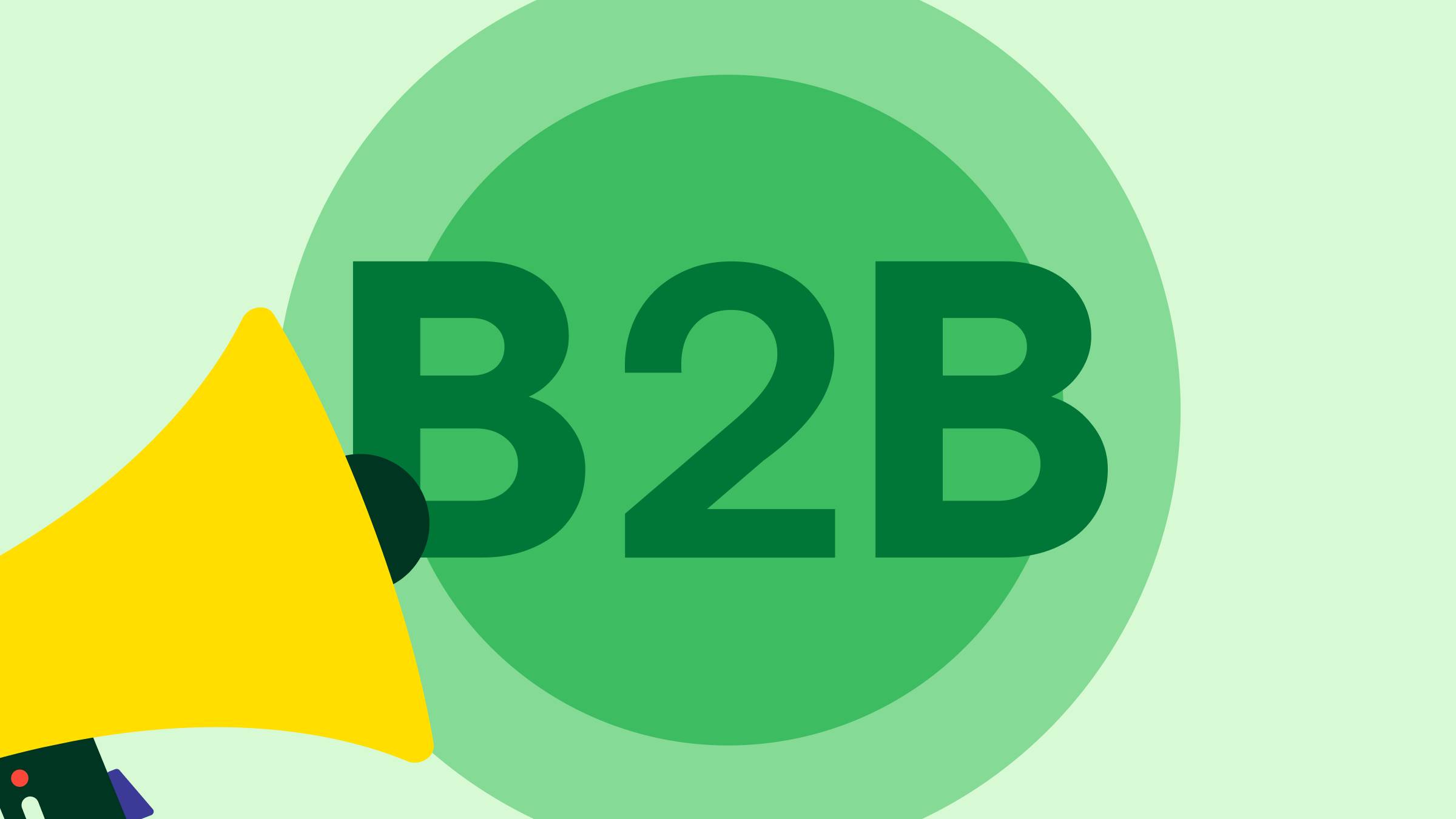Business-to-business marketing helps small businesses overcome the challenges of promoting products to other organizations, forging strong relationships with prospects across multiple touchpoints.
In this article, you’ll learn what B2B marketing is, five effective strategies you can use to promote your brand and how to build a campaign from scratch. We’ll also discuss the top trends shaping the future of B2B marketing.
What is B2B marketing? Definition and example
B2B marketing is all about promoting products or services from one business to another. It builds relationships, addresses organizational needs and supports complex B2B sales processes with multiple stakeholders.
Examples of B2B marketing tactics include:
Thought leadership, where CEOs, CMOs and other leaders demonstrate their expertise in the field
Account-based marketing, where brands deliver personalized content and messaging to a handful of selected buyers
Trade shows and event marketing, where organizations network with sales prospects and showcase new products in person
B2C (business-to-consumer) marketing strategies like SEO, social media and digital marketing are also common, albeit tailored for B2B customers.
A well-defined B2B marketing strategy that combines various tactics and channels enables small businesses to raise brand awareness, drive targeted website traffic and generate high-quality marketing-qualified leads (MQLs) for sales teams.
What’s the difference between B2B and B2C marketing?
The biggest (and most obvious) difference between B2B and B2C marketing is the customer base – i.e., targeting businesses rather than individual consumers.
However, there are several other differences between these common marketing abbreviations, including the following:
B2B marketing | B2C marketing |
|
|
Because of these distinctions, B2B marketing tends to be more involved, advanced and complex than B2C marketing. A hastily assembled Instagram ad may drive leads for a direct-to-consumer e-commerce brand, but it won’t work for a company selling cybersecurity services to enterprises.
Download Your Sales and Marketing Strategy Guide
5 effective B2B marketing strategies that generate high-quality leads
There’s no shortage of B2B marketing strategies to choose from. The right one for your brand will depend on the maturity of your business and the customer journey stage you want to target.
For example, startups might focus on increasing brand awareness through SEO, while mature companies can use thought leadership to build trust and boost brand authority.
With your situation in mind, consider these five B2B marketing strategies for boosting lead generation.
1. Founder-led marketing
Founder-led marketing leverages a company’s leaders as brand ambassadors to raise awareness and demonstrate expertise through thought leadership content, podcasts and social media marketing.
The approach builds trust and authenticity by humanizing brands, which buyers value highly when making B2B purchasing decisions.
Jimmy Kim, founder of eCom Email Marketer Newsletter, an e-commerce and retention marketing newsletter, does a great job of helping his audience overcome common challenges, like the fear of sending too many emails:

Small business owners and executives can use these tips to follow Kim’s lead:
Share genuine stories. Talk about insights and challenges from your own company. Showing you face the same issues as everyone else will build an emotional connection with your audience.
Build in public. Discuss the tactics and strategies your business implements. Be as open as possible by sharing milestones, revenue figures and product roadmaps to show potential customers you’re continually refining your offering.
Engage with your audience directly. Ask for feedback and respond to comments to show you genuinely care what your people think.
You don’t need thousands of followers to start with founder marketing. If your messaging resonates with your ideal customer, posting authentic, helpful content will grow your audience.
2. Account-based marketing
Account-based marketing (ABM) involves targeting high-value companies with highly personalized outreach messages. Rather than trying to appeal to everyone, you hone in on these companies’ specific pain points, creating marketing content that speaks directly to them.
For example, a cybersecurity firm might identify 50 enterprise prospects and create personalized email campaigns that cover specific ways to protect their business. The company could even offer one-on-one training or send personalized gifts to each prospect.
Contextual advertising and brand safety platform GumGum took account-based marketing to another level when it targeted T-Mobile CEO John Legere with a custom comic book:

ABM is a promising tactic for growing sales, according to research by LinkedIn and Ipsos. The study shows that prioritizing high-value accounts is the number one habit of top sellers.
Getting started with ABM takes teamwork. Marketing and sales must work together to create a list of high-value accounts and deliver coordinated and targeted messaging across multiple channels, including:
Email
Social media
Direct mail
Note: Use ABM software to centralize your efforts, monitor success and track each account’s evolving needs.
3. Webinars and video marketing
Video marketing is a powerful way to engage potential customers in an easy-to-consume format. It’s very popular, with 89% of businesses using video as a marketing tool, according to research by Wyzowl.
Webinars are a form of video marketing that helps brands grow their business while building authority. Marketers can use these live events to educate prospects on a topic while showing how their product or service can help.
For example, software provider WebinarNinja has a webinar-based course that teaches businesses how to grow using webinars.

It doesn’t take much to get started with webinars. All you need is a laptop, a webcam and video recording software.
Choose a compelling topic that addresses your audience’s challenges and send follow-up emails to attendees with additional resources. Providing options for next steps will allow you to start nurturing customer relations immediately.
4. Social media marketing
B2B brands can use social media platforms like LinkedIn, TikTok and X (formerly Twitter) to engage directly with prospects, promote content and run digital ads.
Most B2B businesses use social media to raise brand awareness and nurture prospects. For example, social media management tool Buffer uses LinkedIn to promote recent articles and share company insights:

Social media is a great way to engage with prospects throughout the buyer’s journey, helping them learn more about your company, products and values. Social marketing also lets you connect with industry influencers who can expand your reach by sharing your content.
LinkedIn is a great place for SMBs to start social media marketing campaigns, with 85% of marketers saying it delivers the most value.
5. Search engine optimization
Search engine optimization (SEO) is the process of improving your website to rank higher in search engine results. Ranking for relevant terms can drive high-intent prospects to your website.
B2B brands can take things one step further by combining SEO and content marketing to create educational resources targeting long-tail keywords with less competition.
Small businesses won’t necessarily be able to compete with major players for broad, high-volume keywords like “cybersecurity software”. However, they can compete for longer, less searched-for phrases like “cybersecurity software for small business”.
Pipedrive’s blog is an excellent example of SEO-focused content marketing. It offers sales tips, best practices, industry insights and reviews that help businesses to solve their problems and choose the best tools.

The detailed and actionable nature of each article sets Pipedrive’s content apart from competitors’ content. Actionable advice elevates the articles above other SEO content and encourages readers to use Pipedrive’s products to achieve their goals.
With the rise of AI content generators, it’s even more important to create detailed and helpful content that solves your users’ pain points and differentiates your brand from every other page-one result.
How to create a B2B marketing campaign in 5 steps
Creating a B2B marketing campaign requires a strategic approach to provide the right content for the right audience on the right channels.
Increase your chances of generating high-quality leads by following these five steps.
1. Define your goals
Start the process by defining your marketing plan’s goals. Set marketing OKRs (objectives and key results) to focus your efforts and measure your progress.
Defining OKRs helps you choose the best tactics, channels, content and KPIs when building a campaign.
Your OKRs should be SMART: specific, specific, measurable, attainable, relevant and time-bound.

Your OKRs should also align with your wider business goals and maturity level.
For example, a startup that wants to raise brand awareness might set a goal to increase website traffic by 75% in three months. On the other hand, a mature company might want to generate 100 MQLs within the next quarter.
Create your own OKRs using the following simple formula:
I want to [your marketing objective] by [quantifiable increase or amount] within [timeframe].
So an insurance provider looking to increase its SEO presence might say:
I want to increase page one rankings in Google by 50% within six months.
2. Research your audience
A deep understanding of your target audience will help you identify the best ways to reach prospects and create relevant content – improving engagement and the likelihood of making sales.
Work with your B2B sales team and use data from your CRM to create in-depth buyer personas and ideal customer profiles (ICPs) that accurately portray your target audience.
Note: A buyer persona describes a person, while an ICP describes the kind of company you want to target.
If you were a cybersecurity provider targeting B2B SaaS brands, your ICP might look like this:

Conduct market research around your audience’s challenges. This understanding will help you create highly relevant content and find ways to better position your product in the current business climate.
3. Choose your channels and create content
Choose your marketing channels based on who you’re targeting and what you want to achieve.
Find the right B2B marketing channels using the table below:
Channel | When to use it |
Organic social media | Great for building brand awareness and nurturing relationships |
SEO | Best for generating leads at the top and middle of the funnel |
Paid ads | Effective at driving bottom-of-the-funnel leads |
Email marketing | Excellent at nurturing existing leads, retaining customers and building loyalty |
Webinars | Suitable for educating users at the top and middle of the funnel |
Trade shows | Powerful B2B strategy that works at all funnel stages |
Don’t overwork yourself by targeting too many channels at once. Wait until you see results with one channel before experimenting with others.
Focusing on a single channel will also streamline content creation. The fewer channels you use, the less content you’ll need to create and the more time you can spend perfecting your messaging.
Align your content with your marketing funnel. For example, blog posts are a great top-of-the-funnel asset, while case studies and e-books are better suited to bottom-of-the-funnel marketing.

Use content marketing automation to increase your productivity and create more content without spending more budget.
For example, Pipedrive’s AI email writer can produce personalized marketing emails at scale. Marketers just need to enter a one-sentence prompt, and the tool will generate a high-converting email using CRM and customer data.

There are plenty of AI marketing tools available to help you streamline processes. For example, B2B marketing companies can use ChatGPT or Jasper to create blog posts and whitepapers, Canva’s Magic Studio to create e-book designs and HeyGen for video marketing.
4. Set up your CRM to capture leads
Set up your CRM to capture leads before launching your campaign. Doing so will help you organize, prioritize and nurture the prospects you acquire.
For example, Pipedrive’s LeadBooster add-on uses the following features to capture leads:
Chatbot – Engage visitors round the clock with automated chatbots that capture key information and direct visitors to relevant pages
Web chat – Pick up where chatbots leave off and speak to prospects directly via live chat functionality
Web forms – Create custom embeddable forms to capture visitor information and send leads to your CRM

Imagine a cybersecurity company using SEO and content marketing to drive leads. The B2B brand could add a chatbot to every blog post, programming it to start a conversation when users have spent two minutes on the page.
The company could also use a web lead form to capture a prospect’s name, job title and email address for a whitepaper download.
LeadBooster automatically saves everything to the company’s CRM, centralizing all the data so sales teams can send follow-up messages or call the prospects directly.
5. Optimize and improve results
Use analytics and reporting tools to measure your success and find ways to improve your campaigns.
Start by tracking relevant marketing metrics. Use the table below to choose KPIs that align with your goals.
Funnel stage | Metrics to track |
Top of funnel metrics | Website traffic, lead volume, clickthrough rate, bounce rate |
Middle of funnel metrics | Engagement rate, time spent on site, lead quality, MQL to SQL conversion rate |
Bottom of funnel metrics | Customer acquisition cost, conversion rate, customer lifetime value |
A marketing analytics platform like Google Analytics will track most of this data. You may also need a channel’s built-in analytics tool, like LinkedIn Page analytics or your email analytics.
Use analytics data to optimize your campaigns. For example, if your SEO campaign drives traffic but not leads, revisit your articles and look for ways to add gated content or additional product mentions.
3 B2B marketing trends SMBs need to know for 2025
B2B marketing strategies are evolving fast due to technological leaps, rapidly changing consumer preferences and AI. Small business owners must understand and embrace the latest trends to compete with major players and serve customer needs.
Here are three of the most important trends shaping B2B marketing today.
1. AI and marketing automation
AI is a major driver of B2B marketing success in 2025. It helps small businesses automate repetitive tasks, uncover hidden insights that humans miss and deliver hyper-personalized messages at scale.
Here are some specific ways you can use AI in marketing:
Use Pipedrive’s AI email writer to create personalized emails for prospects. It analyzes past communication patterns and customer profiles to develop engaging messages from a single prompt.
Implement an AI social media marketing tool that schedules posts, automatically creates content and suggests optimal posting times. It will help you improve your social media engagement and drive greater brand awareness.
Add AI-powered chatbots to your website to automate lead generation and qualification processes. AI chatbots let you generate leads around the clock, score them automatically and send them straight to the best sales rep.
Implement one or two of the above use cases immediately to prevent your team from falling behind in the AI race.
2. Mobile-first marketing
How your B2B marketing looks on a smartphone can impact the traffic you receive and the number of leads you convert.
Research by BCG finds that 80% of B2B buyers use smartphones at work and more than 60% say devices play a significant role in purchases. If your message isn’t optimized for small screens, it isn’t going to engage them.
Moreover, Google’s mobile-first indexing means your mobile site’s performance directly impacts search rankings and organic traffic acquisition. Well-optimized sites rank higher.
Use the following tactics to adopt a mobile-first approach to your B2B marketing efforts.
Mobile tactic | Explanation and advice |
Increase your website’s speed | Slow websites can lead to high bounce rates and lower Google rankings. Give mobile users a fast-loading website by:
|
Create mobile-optimized email campaigns | Designing emails for smartphones creates a better user experience and can increase click-through rates. Make your emails mobile-friendly by:
|
Experiment with SMS marketing | SMS marketing lets you contact leads directly on their phones, increasing engagement and the chances your message gets seen. Implement SMS marketing by:
|
Mobile-first marketing improves the user experience, engagement and conversion rates of your campaigns.
3. Brand-led marketing and storytelling
Brand-led marketing and storytelling are where companies use their brand identity and values to create meaningful, engaging messages that resonate with buyers.
Product features and benefits aren’t enough to close sales in an increasingly competitive market. Consumers care about who you are, where you’ve come from and what sets you apart.
Investing in brand-led marketing will help customers associate your brand with a specific set of core values. Connecting to values builds trust and helps nurture strong customer relationships, which can lead to new business.
Start forming your brand story by:
Defining your brand purpose. Clearly articulate why your brand exists and how you serve customers.
Crafting a compelling narrative. Create a brand story that reflects your values and guides content creation. Develop strong editorial guidelines that make it easy to apply your brand narrative when creating content.
Aligning your messaging across channels. Maintain a unified tone of voice and style across all sales communications to build brand recognition and trust.
The above strategies will also differentiate your offering in a sea of AI content. Today, any B2B marketer can write a blog post or create an email using generative AI. Only companies that invest in brand marketing can differentiate themselves effectively.
Final thoughts
Generating leads from a B2B marketing campaign requires SMBs to understand their target audience’s pain points, create educational content and nurture relationships across multiple touchpoints.
You also need a way to capture every lead. For that, use Pipedrive’s CRM for marketing.
Pipedrive makes capturing and understanding customer behavior patterns easy. It lets you send personalized content that increases engagement and converts buyers. Start a free 14-day trial to see Pipedrive’s capabilities for yourself.










